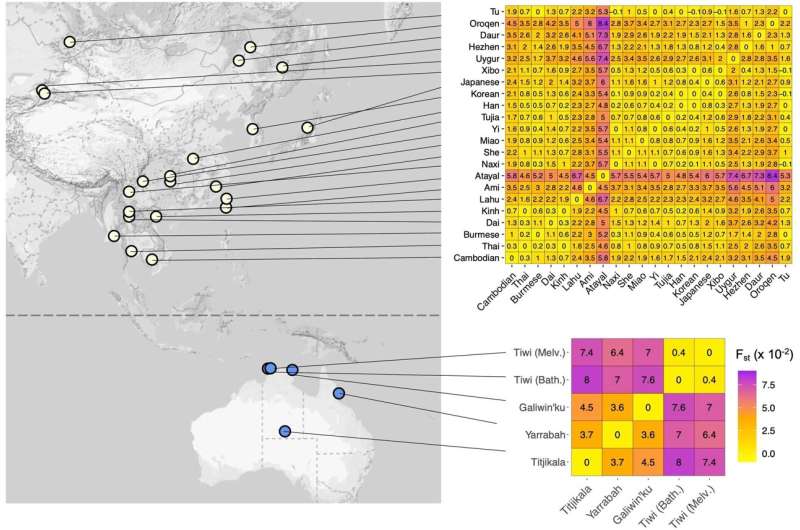This article has been reviewed according to Science X's editorial process and policies. Editors have highlighted the following attributes while ensuring the content's credibility:
fact-checked
peer-reviewed publication
trusted source
proofread
DNA discovery opens door to personalized medicine for Indigenous Australians

The most comprehensive analysis of Indigenous Australians' genomes collected to date has revealed an "abundance" of DNA variations—some of which have never been reported anywhere else in the world—paving the way for new, personalized treatments that address health inequities for Aboriginal and Torres Strait Islander peoples.
A team of Australian researchers, led by scientists from The Australian National University (ANU), found that DNA differences between Indigenous Australians living in the Tiwi Islands and Indigenous peoples living in the Australian desert are equivalent to comparing the genetic information of someone from Bangladesh to the United Kingdom.
The researchers detected hundreds of thousands of 'structural gene variants' that affect large segments of DNA. These variants occur naturally in different individuals of a population, make up most of the genetic differences between individuals, and may be linked to genetic disease in some families.
"The DNA sequencing shows for the first time this level of DNA variation observed anywhere else in the world outside of Africa, reflecting Aboriginal and Torres Strait Islander peoples' deep cultural and linguistic diversity and long-standing connection to the Australian continent," Dr. Hardip Patel, from ANU, said.
"Some of the DNA variations we discovered appear to be exclusively found in Indigenous Australians, while others appear to be found only in one out of the four Indigenous communities that we consulted and worked with.
"Previously, we've had to try to utilize the DNA of non-Indigenous populations to help diagnose and treat disease among Indigenous Australians, which has proven difficult and is often less reliable. But now we have a new, more accurate, and personalized genomic dataset to build off."
Led by the National Center for Indigenous Genomics (NCIG) at ANU, research teams examined the DNA of 160 Indigenous Australians from four Aboriginal communities in the Central Desert, Far North Queensland, and two islands off the coast of the Northern Territory.
It's hoped the research will improve health outcomes for Indigenous Australians by enabling tailored treatments for a range of conditions, including diabetes, coronary disease, and cancer—all of which disproportionately impact Indigenous peoples compared to the rest of the Australian population.
"Aboriginal people have long said you can't treat us the same because we are so different. Having scientific proof to show this is true is remarkable," ANU Associate Professor Azure Hermes, a proud Gimuy Walubara Yidinji woman and deputy director of NCIG, said.
"Clinicians must realize treatment options for Indigenous Australians can't be viewed through a one-model-fits-all lens. We are not a single genetic group and can't be lumped into one category."
Dr. Ira Deveson, from the Garvan Institute of Medical Research, said, "We identified more than 160,000 structural gene variants, which is more than any previous population-level, long-read study to date."
"The research team discovered at least 300 structural variants in each individual that appear to be unique to Indigenous Australians."
A genome is equivalent to an instruction manual for the body. It is a blueprint that contains all the genetic information we need to grow, develop, function, and respond to the environments in which we live.
Genomics medicine harnesses an individual's genetic information to develop personalized prevention and treatment strategies for a range of health conditions, as well as rare genetic diseases.
"The code embedded in our genome is unique to each individual—it's what makes us different to other human beings. Variations within our genetic code can not only explain the way we look but can sometimes impact our risk of developing certain diseases," Dr. Patel said.
"We still don't understand why Aboriginal people are more prone to health conditions such as kidney disease, diabetes, coronary disease, cancer and other conditions. But genomics might be an important piece of the puzzle that helps unlock some of these answers."
Associate Professor Hermes said the project is also about giving Indigenous communities oversight of how their genetic information is used by science.
"Our goal is to work with and empower Indigenous Australians to take ownership of their genetic information and show them the power of genomics and the health benefits it can deliver," Associate Professor Hermes said.
"It's taken us almost eight years to get to this point and has only been made possible because of guidance by Indigenous communities, careful consultation, building relationships with communities, and understanding their priorities and protocols."
NCIG houses a biobank of 7,000 blood samples from 35 Aboriginal communities across Australia. The center is working in collaboration with Indigenous communities to figure out the best ways to care for and return these samples.
"At ANU, we have established a plan for communities to decide the future use and management of these important blood samples and the data that can be generated from them," Associate Professor Hermes said.
"This is an important step toward long-lasting reconciliation with Indigenous Australians."
The research is published in two separate papers in Nature.
More information: Stephen Leslie, Indigenous Australian genomes show deep structure and rich novel variation, Nature (2023). DOI: 10.1038/s41586-023-06831-w. www.nature.com/articles/s41586-023-06831-w
Ira Deveson, The landscape of genomic structural variation in Indigenous Australians, Nature (2023). DOI: 10.1038/s41586-023-06842-7. www.nature.com/articles/s41586-023-06842-7

















